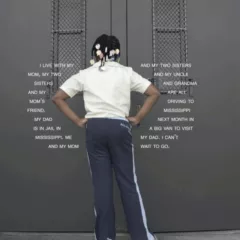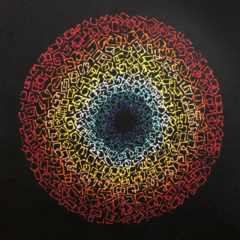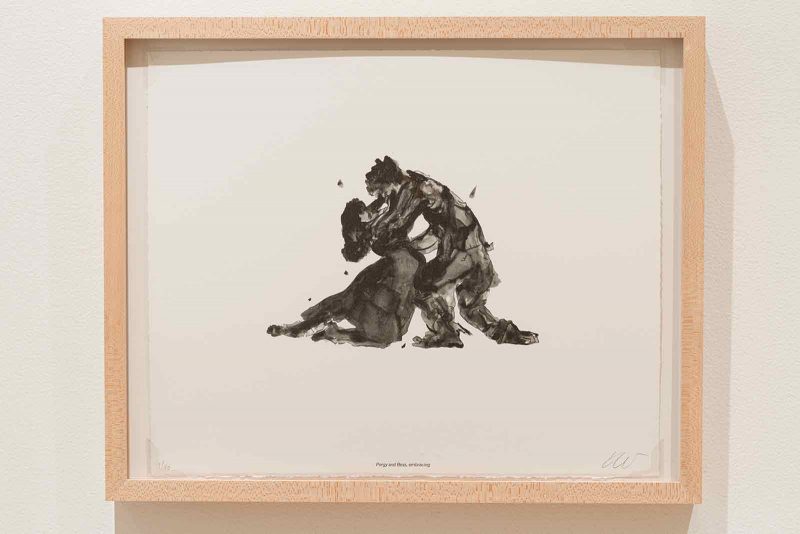
What a pleasure—seeing art in person after a long drought. One of my recent excursions was to Roanoke, VA to the Taubman Museum of Art; we also visited the Virginia Museum of Transportation and the History Museum of Western Virginia / O. Winston Link Museum. My initial purpose for visiting the Taubman was to see the last stop on the national tour for an exhibition I co-curated with my colleague from Rutgers University, Martin Rosenberg. Although the show, Visions of Place: Complex Geographies in Contemporary Israeli Art is now down and packed, you can still visit it virtually through the summer.
The Taubman, a mid-size museum designed by architect Randall Stout, opened its new building in 2008. Before establishing his own firm, Stout worked four years at Skidmore, Owings and Merrill, and seven and a half years at Frank O. Gehry & Associates. The dramatic forms of the building do recall Gehry, but more importantly, respond to the surrounding mountain landscape such as the 77-foot glass peak in the atrium, which suggests the point of the landmark Roanoke Star, and a roofline that reflects the Blue Ridge Mountains. There are eleven galleries and the museum mounts 15-20 exhibitions per year, a very busy schedule. The permanent collection comprises some 2400 objects.
One particularly captivating exhibition, Enduring Voices: African American Art from the David R. and Susan S. Goode Collection is on view through Sunday, September 26, 2021. Private collections are always interesting because seeing the works chosen by individuals is very different from viewing those chosen by committee. They reflect personal preferences and are often modestly sized works due to both financial and storage parameters; this collection has that character. You can sense the care and love with which the works were accumulated. The collection includes many of the most important figures in the history of African American Art: Benny Andrews, Romare Bearden, Elizabeth Catlett, Beauford Delaney, Jacob Lawrence, Faith Ringgold, Whitfield Lovell, Betye Saar, Bob Thompson, and Kara Walker, among others. The works are not completely grouped together in one single gallery, which may seem like a negative, but strolling through the museum and coming across more of these amazing works, indicated by the labels that they are part of this exhibition, is enjoyable. It is like a treasure hunt in the best way possible.
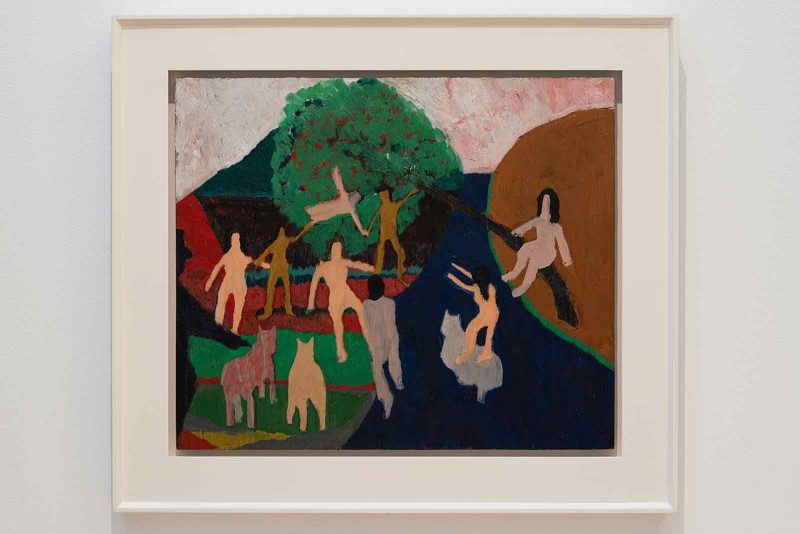
The museum installs smaller exhibitions too, such as a spotlight on a complex work by Eric Standley, “The Lesson of Atticus.” A wall relief made from PVC, it was first on view in the exhibition Form.Print at Towson University’s Center for the Arts Gallery. Imagine my delight in rediscovering it at the Taubman. For Form.Print artists sent digital files and students at TU fabricated and installed pieces in collaboration with faculty and staff. It was a massive undertaking. A catalog is available.
PVC is a new material for Standley as he usually creates with paper. This work will be on view through December 26, 2021. The subject is inspired by the book “To Kill a Mocking Bird” by Harper Lee.
Tara Donovan’s Untitled installation is on view in the lobby of the Taubman Theater, made possible through a long-term loan from an anonymous lender. Both maximal and minimal, two cubes, one comprising thousands of straight pins and the other thousands of toothpicks, are familiar media to those who know Donovan’s work. They are visible from outside the museum; from inside, it appears as if they rest among the rectilinear architectural forms of downtown Roanoke. The Taubman uses every possible space to present both its collection and borrowed contemporary art.
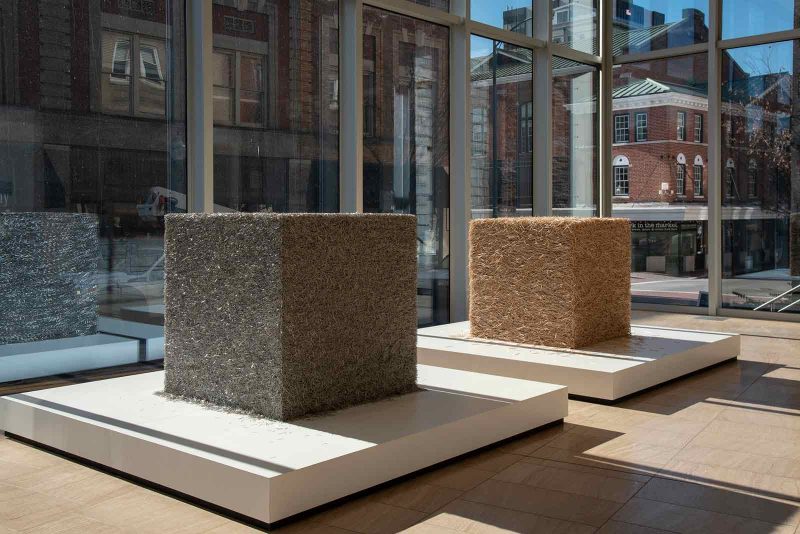
“Untitled,” 1996 (installed 2018), Toothpicks, Courtesy of an anonymous lender,
Photo courtesy of Kyra Schmidt.
After leaving the Taubman, a visit to the Virginia Museum of Transportation was in order. First named The Roanoke Transportation Museum, it originally formed as a partnership between the Norfolk & Western Railway and the City of Roanoke, opening in 1963. Although all modes of transportation are represented, the focus is on Roanoke’s rich rail heritage. Automobile and train examples are the most prevalent, but you can also see some other more unusual vehicles too, such as a Snow-Cat which is employed to create ski trails; buses, trollies, and even an electric locomotive used at the Panama canal are on view. The mail car is very interesting, especially for those of us who enjoy containers and compartments.
Finally, no visit to Roanoke would be complete without seeing the O. Winston Link collection. When we first visited this museum several years ago, it was all Link photographs, but since then The Roanoke History Museum and the O. Winston Link Museum were combined in one space, both operated by the Historical Society of Western Virginia in the former passenger station of the N&W Railway. It is not always a successful marriage. My interest was not so much the decorative objects and artifacts of the history museum but Link’s photographs. He was a fascinating character who was a successful commercial photographer in NYC. For a five-year period in the late 1950s he travelled through Western Virginia and the bordering regions of North Carolina, West Virginia, and Maryland documenting the end of the steam propelled Norfolk & Western Railway and the people, places, and landscape along the right of way. He not only used photography but also captured the sounds of the places he visited on his 21 trips, producing over 2,000 images and 100, 7-inch reels of sound recordings. Link carefully planned his images, setting up the scenes, in essence, posing his subjects. He mostly photographed them at night using lights and flash, resulting in distinctive, high contrast black and white prints. This body of work came to public attention in the 1980s through a book publication, travelling exhibition, and documentary film. Link was involved in the forming of the museum too, which opened in 2004.
From a picturesque view of the mountains to the small and mid-size museums in downtown Roanoke, consider undertaking the nearly six-hour drive from Philadelphia. If you stay in the downtown near the museum, most everything is walkable.
Exhibitions
- Visions of Place: Complex Geographies in Contemporary Israeli Art is no longer on view at the Taubman Museum, but is available online through summer, 2021.
- Enduring Voices: African American Art from the David R. and Susan S. Goode Collection, on view through Sunday, September 26, 2021, Taubman Museum of Art.
- Eric Standley: The Lesson of Atticus (Installation Spotlight), on view through December 26, 2021, Taubman Museum of Art
- Tara Donovan: Untitled, on view through December 31, 2023, Taubman Theater (lobby), Taubman Museum of Art



